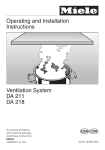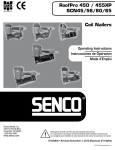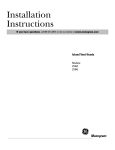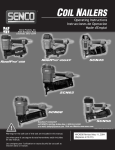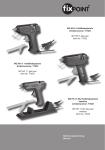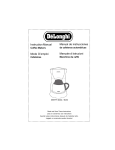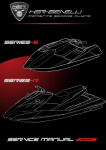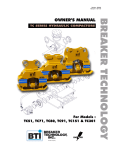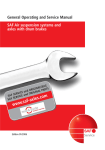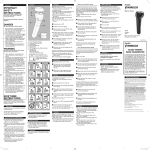Download Miele W 211 Operating instructions
Transcript
Operating and Installation Instructions Ventilation System DA 211 DA 217-3 DA 218 DA 219-3 To prevent accidents and machine damage, read these instructions before installation or use. UV M.-Nr. 05 802 950 2 Contents IMPORTANT SAFETY INSTRUCTIONS Guide to the appliance Functional description Operation Turning on the fan . . . . . . . . . . . . . . . . . . . . . . . . . . . . . . . . . . . . . . . . . . . . . . . . . 11 Selecting the power level. . . . . . . . . . . . . . . . . . . . . . . . . . . . . . . . . . . . . . . . . . . . 11 Delayed Shut Down . . . . . . . . . . . . . . . . . . . . . . . . . . . . . . . . . . . . . . . . . . . . . . . . 12 Turning off the fan . . . . . . . . . . . . . . . . . . . . . . . . . . . . . . . . . . . . . . . . . . . . . . . . . 12 Turning the lighting on/off . . . . . . . . . . . . . . . . . . . . . . . . . . . . . . . . . . . . . . . . . . . 12 Dimming the lighting . . . . . . . . . . . . . . . . . . . . . . . . . . . . . . . . . . . . . . . . . . . . . . . 12 Filter timers . . . . . . . . . . . . . . . . . . . . . . . . . . . . . . . . . . . . . . . . . . . . . . . . . . . . . . 13 Checking the filter timers . . . . . . . . . . . . . . . . . . . . . . . . . . . . . . . . . . . . . . . . . 13 Reprogramming the timers . . . . . . . . . . . . . . . . . . . . . . . . . . . . . . . . . . . . . . . . . . 14 Cleaning and Care Cleaning the casing . . . . . . . . . . . . . . . . . . . . . . . . . . . . . . . . . . . . . . . . . . . . . . . . 16 Grease filters . . . . . . . . . . . . . . . . . . . . . . . . . . . . . . . . . . . . . . . . . . . . . . . . . . . . . 17 Active charcoal filters. . . . . . . . . . . . . . . . . . . . . . . . . . . . . . . . . . . . . . . . . . . . . . . 18 Changing the light bulb . . . . . . . . . . . . . . . . . . . . . . . . . . . . . . . . . . . . . . . . . . . . . 19 After Sales Service Installation instructions Caring for the environment Installation accessories Plywood backing Electrical data Appliance dimensions Installation Retaining plates . . . . . . . . . . . . . . . . . . . . . . . . . . . . . . . . . . . . . . . . . . . . . . . . . . . 32 Attaching the canopy. . . . . . . . . . . . . . . . . . . . . . . . . . . . . . . . . . . . . . . . . . . . . . . 34 Inserting the non-return flap . . . . . . . . . . . . . . . . . . . . . . . . . . . . . . . . . . . . . . . . . 35 Electrical connection . . . . . . . . . . . . . . . . . . . . . . . . . . . . . . . . . . . . . . . . . . . . . . . 36 Air extraction exhaust connection . . . . . . . . . . . . . . . . . . . . . . . . . . . . . . . . . . . . . 36 Recirculation connection . . . . . . . . . . . . . . . . . . . . . . . . . . . . . . . . . . . . . . . . . . . . 37 Attaching the chimney extension. . . . . . . . . . . . . . . . . . . . . . . . . . . . . . . . . . . . . . 38 Air extraction Condensate trap . . . . . . . . . . . . . . . . . . . . . . . . . . . . . . . . . . . . . . . . . . . . . . . . . . 43 3 IMPORTANT SAFETY INSTRUCTIONS Read these Operating Instructions carefully before installing or using the Ventilation System. This appliance is intended for residential use only. Use the appliance only for its intended purpose. The manufacturer cannot be held responsible for damages caused by improper use of the hood. This appliance complies with current safety requirements. Improper use of the appliance can lead to personal injury and material damage. READ AND SAVE THESE INSTRUCTIONS CAUTION For General Ventilating Use Only. Do Not Use To Exhaust Hazardous Or Explosive Materials And Vapors. This appliance is designed to vent cooking smoke and odors only. Be certain your appliance is properly installed and grounded by a qualified technician. To guarantee the electrical safety of this appliance, continuity must exist between the appliance and an effective grounding system. It is imperative that this basic safety requirement be met. If there is any doubt, have the electrical system of the house checked by a qualified electrician. The manufacturer can not be held responsible for damages caused by the lack, or inadequacy of, an effective grounding system. Before connecting the appliance to the power supply make sure that the voltage and frequency listed on the data plate correspond with the household electrical supply. This data must correspond to prevent machine damage. Consult a qualified electrician if in doubt. Installation work and repairs should only be performed by a qualified technician in accordance with all applicable codes and standards. Repairs and other work by unqualified persons could be dangerous and the manufacturer will not be held responsible. 4 IMPORTANT SAFETY INSTRUCTIONS This equipment is not designed for maritime use or for use in mobile installations such as caravans or aircraft. However, under certain conditions it may be possible for an installation in these applications. Please contact the nearest Miele dealer or the Technical Service Department with specific requirements. Before servicing or cleaning the unit, switch power off at the service panel and lock the service disconnecting means to prevent power from being switched on accidentally. When the service disconnecting means can not be locked, securely fasten a prominent warning device, such as a tag, to the service panel. Before discarding an old appliance, unplug it from the power supply and remove the power cord and any doors to prevent hazards. Use Do not allow children to play with or operate the appliance or its controls. Supervise its use by the elderly or infirm. Be careful when preparing a flambé beneath the hood. Flames may be drawn up into the hood by the suction or grease filters may catch fire. Never operate gas burners without pots. Do not leave cooking surfaces unattended while in use. Overheated food, oil and grease can catch fire. Do not use the hood without the grease filters in place. Clean the grease filters regularly. Dirty filters are a fire hazard. Do not use a steam cleaner to clean the hood. Steam could penetrate electrical components and cause a short circuit. In areas subject to infestation by cockroaches or other pest, keep the appliance and its surroundings clean at all times. Any damage caused by cockroaches or other pest will not be covered under warranty. Always turn on the hood when using the cooktop to prevent damage from condensation. 5 IMPORTANT SAFETY INSTRUCTIONS , WARNING - TO REDUCE THE RISK OF A RANGE TOP GREASE FIRE: Never leave surface units unattended at high settings. Boilovers cause smoking and greasy spillovers may ignite. Heat oils slowly on low or medium settings. Always turn the hood “ON” when cooking at high heat or when cooking flaming foods. Clean ventilating fans frequently. Grease should not be allowed to accumulate on the fan or filter. Use proper pan size. Always use cookware appropriate for the size of the surface element. , WARNING TO REDUCE THE RISK OF INJURY TO PERSONS IN THE EVENT OF A RANGE TOP GREASE FIRE, OBSERVE THE FOLLOWING: SMOTHER FLAMES with a close fitting lid, cookie sheet, or metal tray, then turn off the burner. BE CAREFUL TO PREVENT BURNS. If the flames do not go out immediately, EVACUATE AND CALL THE FIRE DEPARTMENT. NEVER PICK UP A FLAMING PAN - You may be burned. DO NOT USE WATER, including wet dishcloths or towels - a violent steam explosion will result. Use an extinguisher ONLY if: – You know you have a Class ABC extinguisher, and you already know how to operate it. – The fire is small and contained in the area where it started. – The fire department is being called. – You can fight the fire with your back to an exit. 6 IMPORTANT SAFETY INSTRUCTIONS Installation , WARNING To reduce the risk of fire only use metal ductwork. When installing the hood, follow the recommended minimum safety distances between a Miele cooktop and the hood: – 22" (55 cm) above electric cooktops, – 26" (65 cm) above gas cooktops, – 26" (65 cm) above an open grill. If local building codes require a greater safety distance, follow their requirement. For non-Miele cooking appliances maintain the safety distances recommended by the appliance manufacturer in their instructions. If there is more than one appliance beneath the hood and they have different minimum safety distances always select the greater distance. Be careful not to damage hidden electrical wiring or plumbing when cutting or drilling into the wall or ceiling. Any fittings, sealant, or materials used to install the ductwork must be made of approved non-flammable materials. Never connect an exhaust hood to an active chimney, dryer vent, vent flue, or room ventilating ductwork. Seek professional advice before connecting an exhaust hood vent to an existing, inactive chimney or vent flue. Ducted fans must always be vented outdoors. Make sure that the airflow in the room is sufficient for combustion and exhausting of all non-electric heating appliances (water heaters, gas cooktops, gas ovens, etc.), otherwise backdrafts may occur. Follow the heating manufacturer’s guidelines and safety standards or those published by the National Fire Protection Association (NFPA), or the American Society for Heating, Refrigeration and Air Conditioning Engineers (ASHRAE). If in doubt, consult an experienced professional. Do not use an extension cord to connect the appliance to electricity. Extension cords do not guarantee the required safety of the appliance, (e.g. danger of overheating). Do not install this hood over cooktops burning solid fuel. 7 Guide to the appliance 8 Guide to the appliance a Chimney extension m Grease filter button b Chimney The indicator above the grease filter button lights when the grease filters need to be cleaned. This button is also used: c Canopy d Control panel e Active charcoal filter f Recirculation vent g Overhead lighting h Grease filters i Light button – to reset the grease filter timer after cleaning the grease filters (see "Cleaning and Care"). – to show how long the grease filters have been in use (see "Operation / Filter timers"). – to change the number of hours counted by the grease filter timer (see "Operation / Reprogramming the filter timers"). n Charcoal filter button j On/Off button (used in recirculation mode only) k Fan power level buttons The indicator above the charcoal filter button lights when the charcoal filters need to be replaced. Four fan speed selection l Delayed Shut Down This button activates the Delayed Shut Down feature. The fan can be set to turn off automatically after either 5 or 15 minutes. This button is also used: – to reset the charcoal filter timer after changing the filters (see "Cleaning and care"). – to show how long the charcoal filters have been in use (see "Operation / Filter timers") – to change the number of hours counted by the charcoal filter timer (see "Operation / Reprogramming the timers"). 9 Functional description The hood offers two modes of operation: Air extraction Recirculation mode The air is drawn in and cleaned by the grease filters and directed outside. Air is drawn through the grease filters and an active charcoal filter. The filtered air is then recirculated back into the kitchen through a vent at the top of the hood’s chimney. The hood comes equipped with a non-return flap. This flap automatically closes when the hood is turned off so that no exchange of outside air and room air can occur. When the hood is turned on, the air pressure of the exhaust fan automatically opens the flap blowing the inside air and cooking odors outside. 10 Before using the hood in recirculation mode, ensure that the active charcoal filters are in place, see "Cleaning and care". Operation Turning on the fan Selecting the power level ^ Press the On/Off button. ^ Use the _ controls to select the desired power level. The fan runs at power level "2". The On/Off indicator lights. & =increases the fan speed $ =decreases the fan speed Level "1" to "3" (green indicators) are usually sufficient for normal cooking. Intensive setting Level "4" (yellow indicator) should be used for a short period when frying or cooking food with a strong aroma. Fan performance The maximum air flow capacity is 625 cfm. Factors such as narrow duct diameter and bends will affect this value. There will also be a slight decrease in airflow for hoods operated in recirculation mode due to the active charcoal filter. Level 1 operates at 40% capacity Level 2 operates at 60% capacity Level 3 operates at 80% capacity Level 4 operates at 100% capacity 11 Operation Delayed Shut Down Turning the lighting on/off If odors or smoke remain in the kitchen after cooking has been completed, the Delayed Shut Down feature can be selected to allow the hood to continue running for either 5 or 15 minutes. The overhead lighting can be turned on and off independently of the fan. ^ Press the light button briefly to turn on the lighting. ^ Press the Delayed Shut Down button while the fan is still running. The light button indicator illuminates. Press once = 5 minute delay (left indicator lights) Press twice = 15 minute delay (right indicator lights) The light button indicator will go out. To cancel the Delayed Shut Down feature press the button again. Turning off the fan ^ Press the On/Off button to turn the fan off. The indicator goes out. Automatic Safety Shut Off The fan will turn off automatically 10 hours after the last button was activated. The lighting however will remain on. ^ Press the On/Off button to turn the fan back on again. 12 ^ Press the light button briefly again to turn off the lighting. Dimming the lighting The brightness of the lighting can be adjusted. ^ While the lighting is turned on, press the light button. The lighting will dim until the button is released. ^ If the button is pressed again, the lighting will brighten until the button is released. If the button is pressed continuously, the light will cycle between bright and dark. ^ Press the light button again to turn off the lighting. Operation Filter timers Checking the filter timers Grease filters To check the percentage of time already used: A timer monitors the hours of fan operation. The indicator for the grease filter will light after 30 hours of operation. The grease filters must then be cleaned. After the grease filters have been cleaned and put in place, the grease filter timer must be reset. ^ To do this, press the grease filter button for about 3 seconds. ^ Press the On/Off button to turn the fan on. ^ Press the grease or charcoal filter button. The indicator will go out. Charcoal filters The timer for the charcoal filter is not preset. Please program this timer, see "Operation/Reprogramming the charcoal filter timer". The charcoal filter indicator will light once the selected time has elapsed. The charcoal filters must then be replaced and the charcoal filter timer must be reset. The number of flashing _ indicators show the percentage of programmed hours that have been used. 1 indicator 2 indicators 3 indicators 4 indicators = = = = less than 25 % less than 50 % less than 75 % less than 100 % This information will remain stored in memory in the event of a power failure. ^ To do this, press the charcoal filter button for about 3 seconds. The indicator will go out. 13 Operation Reprogramming the timers The grease filter timer is preset to 30 hours. This time can be lengthened or shortened to 20, 30, 40 or 50 hours. – A time of 20 hours should be programmed in kitchens with frequent pan or deep frying. – A time of 20 hours should also be programmed if the kitchen is only used occasionally. Otherwise grease which has accumulated over a long period of time will harden on the filters making cleaning more difficult. The indicator for the grease filter and one of the _ indicators will flash. The lit indicator shows the programmed time: 1st indicator from the left 2nd indicator from the left 3rd indicator from the left 4th indicator from the left = = = = 20 hours 30 hours 40 hours 50 hours ^ Use the $ or & button to select the desired time. Reprogramming the grease filter timer ^ Press the On/Off button to turn off the fan. ^ Press the Delayed Shut Down and grease filter buttons at the same time. 14 ^ Store the selection by pressing the grease filter button. If the procedure is not stored within 4 minutes of programming, the hood will automatically default to the "old" data. Operation Reprogramming the charcoal filter timer The active charcoal filter can only be used in recirculation mode and can not be used to exhaust fumes. The charcoal filter timer is not preset. Before using the hood in recirculation mode, the charcoal filter timer must be programmed. ^ Turn off the fan using the On/Off button. ^ Press the Delayed Shut Down and Charcoal Filter buttons at the same time. The indicator for the charcoal filter and one of the _ indicators will flash. The lit indicator shows the programmed time: 1st indicator from the left 2nd indicator from the left 3rd indicator from the left 4th indicator from the left = = = = 20 hours 30 hours 40 hours 50 hours ^ Use the $ or & button to select the desired time. ^ Store the selection by pressing the charcoal filter button. If the procedure is not stored within 4 minutes of programming, the hood will automatically default to the "old" data. 15 Cleaning and Care Before cleaning or servicing the hood, disconnect it from the power supply by either removing the fuse, unplugging it from the outlet or manually "tripping" the circuit breaker. Cleaning the casing ,Never use abrasive cleaners, scouring pads, steel wool or caustic (oven) cleaners on the hood. They will damage the surface. ^ All external surfaces and controls can be cleaned with warm water and liquid dish soap applied with a soft sponge. ^ Wipe dry using a soft cloth. Do not use too much water when cleaning the controls. Water could penetrate into the electronics and cause damage. Avoid: – cleaning agents containing soda, acids or chlorides, – abrasive cleaning agents e.g. powder or cream cleansers, – abrasive sponges, e.g. pot scourers or sponges which have been previously used with abrasive cleaning agents. These will damage the surface. 16 Stainless steel Stainless steel surfaces can be cleaned using a non-abrasive stainless steel cleaner. To help prevent resoiling, a conditioner for stainless steel can also be used. Apply sparingly with even pressure. Stainless steel colored controls These controls may become discolored or damaged if not cleaned regularly. Do not use a stainless steel cleaner on these controls. Cleaning and Care Grease filters The reusable metal grease filters remove solid particles from the vented kitchen air (grease, dust, etc). The grease filters should be cleaned every 3 - 4 weeks or whenever the grease filter indicator lights. A dirty filter is a fire hazard. Depending on the detergent, cleaning the grease filters in a dishwasher may cause permanent discoloration of the filter surface. Performance of the filter will not be affected by this discoloration. ^ After cleaning, the filters can be placed on a towel to air dry. ^ While the filters are removed, clean any dirt or grease from the filter casing to prevent the risk of fire. When putting the grease filters back make sure that the locking clips are visible facing down towards the cooking surface. If a filter is incorrectly installed, insert a small screwdriver into the slit along its edge to disengage it from the casing. ^ To remove the grease filters press the locking clips in towards the middle of the filter. Holding carefully, lower and remove the filter. ^ Clean the filters - by hand: use a scrub brush in warm water with a mild detergent. - in a dishwasher: place the filters in the lower basket, making sure that the spray arm is not blocked. ^ After returning the grease filters, press the grease filter button for 3 seconds to reset the timer. The indicator light will go out. ^ If the grease filters are cleaned before the timer has reached its maximum, the grease filter button should be pressed for 6 seconds to reset the counter to zero. 17 Cleaning and Care Active charcoal filters In recirculation mode two active charcoal filters must be used in addition to the grease filters. The charcoal filters are designed to absorb cooking odors. Replacement active charcoal filters can be ordered from the Miele Technical Service Department. USA 1-800-999-1360 CDN 1-800-565-6435 Please quote part # 03 284 681. ^ Remove the grease filters to access the charcoal filters. Follow the instructions supplied with the active charcoal filters. Replace the active charcoal filters when the charcoal filter indicator lights. Replace the filters at least every 6 months or when they no longer absorb odors efficiently. 18 ^ After replacing the charcoal filters, press and hold the charcoal filter button for about 3 seconds to reset the charcoal filter timer. The indicator light will go out. ^ If the charcoal filters are replaced before the timer has reached its maximum, the charcoal filter button should be pressed for 6 seconds to reset the counter to zero. Cleaning and Care Changing the light bulb Before changing the light bulbs, disconnect the hood from the power supply by either removing the fuse, unplugging it, or manually "tripping" the circuit breaker. When in use halogen bulbs become extremely hot, and they can burn your hands. Do not attempt to change the bulbs until they have had sufficient time to cool down. Do not touch the bulb surface. Fingerprints or body oils deposited on the bulb will decrease the life of the bulb. Follow the bulb manufacturer’s instructions. ^ To change the halogen bulb first remove the lamp cover, a. ^ Pull the bulb, b, out of its socket and replace with a new one. ^ Return the lamp cover, a. Never use the lighting without the lamp cover, a, in place. The glass is specially made to filter harmful light rays. 19 After Sales Service In the event of a fault which you can not correct yourself please contact: – Your Miele Dealer or – The Miele Technical Service Department USA 1-800-999-1360 [email protected] CDN 1-800-565-6435 [email protected] When contacting the Technical Service Department, please quote the model and serial number of your appliance. These are shown on the data plate which is visible when the grease filter is removed. 20 Installation Instructions 22 Caring for the environment Disposal of packing material Disposal of an old appliance The cardboard box and packing materials protect the appliance during shipping. They have been designed to be biodegradable and recyclable. Please recycle. Old appliances may contain materials that can be recycled. Please contact your local recycling authority about the possibility of recycling these materials. To prevent suffocation of children, ensure that any plastic wrappings, bags etc. are disposed of safely and kept out of their reach. Before discarding an old hood, unplug it from the outlet and cut off its power cord to prevent hazards. 23 Installation accessories 24 Installation accessories a 2 recirculation vents (recirculation mode only) b 2 protective shields prevent scratches to the chimney during installation. c 1 protective shield prevents scratches from the canopy during installation. d 1 diverter (recirculation mode only) 12 large headed screws 5 x 40 mm for securing the retaining plates and the canopy. (S8 wall anchors included in the packaging are not for use in USA / CDN.) e 1 flex hose for connecting the diverter to the exhaust connection. f 2 hose clips for securing the ducting. 2 M 6 locking nuts for securing the motor assembly. g 1 reducing collar for use with 5" (125 mm) exhaust ducting. h 1 non-return flap for vented air extraction only. 4 screws 3.9 x 7.5 mm for securing the chimney and the chimney extension i Upper retaining plate B secures the chimney extension. j Middle retaining plate C for additional stability of the chimney. k Lower retaining plate A secures the canopy and motor assembly. CAUTION: During the installation process please be careful of sharp edges that can cause harm. 25 Plywood backing The majority of the weight of the installed ventilation system will be supported by retaining plate A. It must be firmly attached to the stud framing behind the drywall. If studs are not available in the required locations, a plywood backing (min. 1 /2" (13 mm) thick) spanning at least two studs must be installed. Failure to adequately support the weight as stated may result in the ventilation system falling off the wall, causing personal injury and property damage. (If plywood backing is not needed, proceed to "Attaching the retaining plates to the wall." ) To install a plywood backing board ^ Hold retaining plate A against the wall so that the marks are visible through the holes of the plate (see "Installation / Retaining plate A"). Draw a line around the plate’s perimeter, then set aside the plate. ^ Make a cutting line 3" (76 mm) above and 3" (76 mm) below the outline of plate "A". ^ Find the studs to the left and right of the mounting location by tapping the wall or using a stud finder. ^ Mark a vertical cutting line along the center of each stud. Be careful not to damage any wiring or plumbing that may be located behind the wall. Make sure that the power supply to the area where this installation is being performed has been turned off at the breaker panel before cutting into the wall. ^ Remove the drywall between the cutting lines and replace it with plywood of a matching thickness (min. 1/2" (13 mm) thick). Tape the joints and refinish the wall. ^ Proceed to "Attaching the Retaining plates to the wall" to complete the installation. ^ Make a mark, S + 16 3/4" (425 mm) above the cooktop and on the centerline. ^ Make a second mark 12 3/4 " (324 mm) underneath the first one. 26 Electrical data All electrical work should be performed by a qualified electrician in strict accordance with national and local safety regulations. Installation, repairs and other work by unqualified persons could be dangerous. The manufacturer can not be held responsible for unauthorized work. Ensure that power to the appliance is OFF while installation or repair work is performed. Verify that the voltage, load and circuit rating information found on the data plate (located behind the grease filters), match the household electrical supply before installing the hood. Important The hood comes equipped with a 5 ft (1.5 m) power cord with a NEMA 5-15 molded plug for connection to a 120 VAC, 60 Hz, 15 A power outlet. Maximum load DA 217-3 . . . . . . . . . . . . . . . . . . . 390 W DA 211, 218, 219-3 . . . . . . . . . . . 410 W Lighting DA 217-3 . . . . . . . . . . . . . . . . . 2 x 20 W DA 211, 218, 219-3 . . . . . . . . . 3 x 20 W Voltage . . . . . . . . . . . . . . . . . . . . . 120 V Frequency . . . . . . . . . . . . . . . . . . 60 Hz Circuit rating. . . . . . . . . . . . . . . . . . 15 A If there is any question concerning the electrical connection of this appliance to your power supply, please consult a licensed electrician or call Miele’s Technical Service Department. USA 1-800-999-1360 CDN 1-800-565-6435 WARNING: THIS APPLIANCE MUST BE GROUNDED 27 Appliance dimensions 28 Appliance dimensions Do not install this exhaust hood over cooktops burning solid fuel. When installing the hood, make sure that the following minimum distance (S) between the top of a Miele cooking surface and the bottom of the hood is: - 22" (55 cm) above electric cooktops - 26" (65 cm) above gas cooktops - 26" (65 cm) above an open grill Standard unit height H: DA 211 Extraction. . . . . . . . . . . . 29 1/8" - 38 9/16" . . . . . . . . . . . . . . . . . . . (740 - 980) mm Recirculation . . . . . . . 32 11/16" - 41 15/16" . . . . . . . . . . . . . . . . . . (830 - 1065 mm) DA 217-3 Extraction . . . . . . . . . . . . . 28" * - 37 3/8" . . . . . . . . . . . . . . . . . . . (710* - 950) mm Recirculation . . . . . . . . . . 31 1/2" - 40 3/4" . . . . . . . . . . . . . . . . . . (800 - 1035 mm) For non-Miele cooking appliances maintain the safety distances recommended by the cooktop manufacturer in their installation and operating instructions. DA 218 Extraction . . . . . . . . . . . . 28 1/8" - 37 5/8" . . . . . . . . . . . . . . . . . . . (715 - 955) mm Recirculation . . . . . . . 31 11/16" - 40 15/16" . . . . . . . . . . . . . . . . . . (805 - 1040 mm) If there is more than one appliance beneath the hood and they have different minimum safety distances always select the greater distance. DA 219-3 Extraction. . . . . . . . . . . . 28 3/4" - 38 3/16" . . . . . . . . . . . . . . . . . . . (730 - 970 mm) Recirculation . . . . . . . . 32 5/16" - 41 9/16" . . . . . . . . . . . . . . . . . . (820 - 1055 mm) See "Warning and Safety instructions" for further information. 26" (65 cm) is recommended for all installations to allow for optimum work space under the hood. Read the entire installation procedures and determine height (S) before beginning the installation. Installation producers differ depending on the model and venting method. If the hood is fitted flush to the ceiling make sure that the remaining distance to the ceiling is not greater or less than appliance height H. * With air extraction to the rear through a wall the total height must be at least 31 1/8" (790 mm). To fit the chimney, distance A between the top of the chimney and the ceiling must be at least 7/8" (20 mm). Cut out area in wall or ceiling for entrance of 6" (150 mm) ductwork or 5" (125 mm) ductwork with a reducing collar. 29 Appliance dimensions If the standard unit height H is not suitable to the kitchen’s ceiling height, longer optional chimney extensions are available from your Miele dealer or Miele’s Technical Service Department. DA 211 Extraction 1 Recirculation 9 Standard unit H 29 /8" - 38 /16" 740 mm - 980 mm 32 11/16" - 41 15/16" 830 mm - 1065 mm DATK 217/219 605 38 9/16" - 48" 980 mm - 1220 mm 42" - 51 3/16" 1066 mm - 1300 mm DATK 217/219 840 48" - 57 1/2 " 1220 mm - 1460 mm 51 3/16" - 60 1/2" 1300 mm - 1536 mm DA 217-3 Extraction Recirculation Standard unit H 28" - 37 /8" 710 mm - 950 mm 31 1/2" - 40 3/4" 800 mm - 1035 mm DATK 217/219 605 37 3/16" - 46 7/16" 945 mm - 1180 mm 40 3/4" - 50" 1035 mm - 1270 mm DATK 217/219 840 46 7/16 " - 55 11/16 " 1180 mm - 1414 mm 50" - 59 1/4" 1270 mm - 1505 mm 30 3 Appliance dimensions DA 218 Extraction Recirculation Standard unit H 28 1/8" - 37 5/8" 715 mm - 955 mm 31 11/16" - 40 15/16" 805 mm - 1040 mm DATK 217/219 605 37 5/8" - 47" 955 mm - 1195 mm 41" - 50 3/16" 1041 mm - 1275 mm DATK 217/219 840 47" - 56 1/2 " 1195 mm - 1435 mm 50 3/16 - 59 1/2" 1275 mm - 1511 mm DA 219-3 Extraction Recirculation Standard unit H 28 3/4" - 38 3/16" 730 mm - 970 mm 32 5/16" - 41 9/16" 820 mm - 1055 mm DATK 217/219 605 38 3/16" - 47 5/8" 970 mm - 1210 mm 41 9/16" - 50 13/16" 1056 mm - 1290 mm DATK 217/219 840 47 5/8 " - 57 1/16 " 1210 mm - 1450 mm 50 13/16" - 60 1/16" 1290 mm - 1526 mm 31 Installation Retaining plates The ventilation system will be mounted to the wall through the use of retaining plates. Plate A is installed first, followed by plate B. Plate C should only be used if the distance between plate A and plate B is greater than 14 3/8" (365 mm). 32 Attaching the retaining plates to the wall ^ Before fitting the retaining plate draw a vertical line centrally above the cooktop on the rear wall. ^ Mark measurement S from the cooktop surface upwards (see "Appliance dimensions"). This marks the height of the lower rim of the hood. Installation Retaining plate A ^ Drill two 1/8" (3 mm) holes, one at S + 4" (100 mm) and one at S + 16 3/4" (425 mm) on the center line for the retaining plate (see "Appliance dimensions"). ^ Lightly secure retaining plate A into position using 5 x 40 mm screws through the two holes and use the notches to align with the center line. ^ Drill 4 more 1/8" (3 mm) holes through the now fitted retaining plate. ^ Screw two 5 x 40 mm screws into the upper two holes. Retaining plate B ^ Hold retaining plate B to the wall and push up until it is directly below the ceiling. Use the notches and the center line to align it horizontally. Mark the 2 drill holes on the wall. ^ Drill two 1/8" (3 mm) holes into the wall. ^ Secure the retaining plate with two 5 x 40 mm screws. 33 Installation Retaining plate C Retaining plate C should only be used if dimension Y is greater than 14 3/8" (365 mm.) It provides additional stability for the chimney extension. Attaching the canopy ^ Hang the canopy on the angled brackets on retaining plate A. ^ At a maximum distance of 14 3/8" (365 mm) from the ceiling hold retaining plate C against the wall and use the notches to align it with the center line. Mark the two drill holes. ^ Drill two 1/8" (3 mm) holes into the wall. ^ Secure retaining plate C with two 5 x 40 mm screws. ^ Secure the canopy with 5 x 40 mm screws into each drilled hole. 34 Installation Inserting the non-return flap ^ Air extraction: If a non-return flap is not present in the venting system, the non-return flap supplied must be fitted into the exhaust connection on the motor. The flaps must open upwards. Attaching the motor assembly ^ First loosely screw the two locking nuts onto the threaded bolts on retaining plate A. Leave a gap of 1/8" (3 mm) for hanging the motor on. ^ The hood is designed for 6" (150 mm) exhaust ducting. If 5" (125 mm) exhaust ducting is used the reducing collar must be fitted into the exhaust connection on the motor (see "Air extraction"). ^ Recirculation mode: The non-return flap is not required. ^ Fit the motor assembly onto the hooks on retaining plate A and slide down behind the nuts. ^ Tighten the nuts. 35 Installation Electrical connection Before connecting the appliance read the "Warning and Safety Instructions" and the "Electrical data" sections. Air extraction exhaust connection ^ Connect the ductwork to the exhaust connection using whatever means are appropriate for the type of ductwork being installed (hose clamp, duct tape, etc.) ^ Plug the 2 connectors on the canopy into the corresponding receptacles left and right of the motor assembly. Insert the 4 prong connector into the receptacle left of the motor assembly. Insert the 6 prong connector into the receptacle right of the motor assembly. ^ Secure the cords with the ties, as shown above. ^ Plug in the power cord. 36 ^ Direct the duct through the back wall or the ceiling. ^ See "Air extraction" for further details. Installation Recirculation connection Recirculation mode is used when venting to the outside of the building is not possible. ^ Slip the hose clamps over the flex hose onto the diverter and the motor assembly exhaust connection. Once in place, tighten the hose clamps. ^ Slide the diverter on to the brackets of plate B. Active charcoal filters must be used in the recirculation mode. 37 Installation Attaching the chimney extension The use of a chimney extension, allows the hood to be installed at various distances from the ceiling. NOTE: The extension must be intalled in relationship to the method of venting; Extraction or Recirculation. Recirculation Air extraction The extension piece has vented openings on one end. These vents are required for recirculation mode and will be closest to the ceiling when installed. For air extraction, the vents are not required and are covered by the chimney. 38 Installation ^ Screw the extension piece firmly to the upper retaining plate using two 3.9 x 7.5 mm screws. ^ Remove the protective foil from chimney extension. ^ Cover the screws with the supplied cap covers. ^ Bend the top hanging tabs 45° inwards. This will make installing the extension easier. Be careful of sharp edges. ^ Only for recirculation: With the slats pointing downwards, install the recirculation vents through the extension piece and into the diverter. Recirculation Air extraction ^ Pull the chimney extension slightly outwards and snap over the upper retaining plate B. When installing for recirculation, ensure that the vents are positioned so they line up with the diverter. 39 Installation Attaching the chimney ^ Remove the protective foil from the chimney. ^ Fold the protective shield at the top. ^ Remove the adhesive backing from the shield. ^ Stick the shield to the chimney extension so that it is smooth and flush with the bottom. 40 ^ Remove the backing from the adhesive strips on the protective shield. ^ Attach the protective shield to the front of the chimney so that it protrudes slightly below the bottom edge. Installation ^ Secure the chimney to reatining plate A on both sides with two 3.9 x 7.5 mm screws. ^ Remove the protective foil from the canopy. ^ Pull the chimney apart slightly and slide it over the chimney extension. Do this carefully to prevent scatching the two pieces. ^ Slide the chimney down aligning its lower screw holes with those on the side of retaining plate A. ^ Remove the protective shields. ^ Before using the appliance remove the grease filter and remove the protective foil from the filter frame. Return the filter. If the chimney is not tall enough an optional chimney extension can be ordered. See "Installation / Appliance dimensions". 41 Air extraction ,WARNING Danger of toxic fumes. Gas cooking appliances release carbon monoxide that can be harmful or fatal if inhaled. The exhaust gases extracted by the hood should be vented outside of the building only. Do not terminate the exhaust ducts in attics, garages, crawlspaces, etc. To reduce the risk of fire, only use metal ductwork. Please read and follow the "IMPORTANT SAFETY INSTRUCTIONS" to reduce the risk of personal injury. Follow all local building codes when installing the hood. 42 Exhaust ducting and connections – The ducting should be as short and straight as possible, and the number of sharp bends should be minimized. – For most efficient air extraction, the diameter of the ductwork should not be less than 6" (150 mm). Use of flat ducts also reduces the air extraction efficiency. – Noise levels of the hood will increase if flat ducts or round ducts of less than 6" (150 mm) in diameter are used. – Use smooth or flexible pipes made from approved non-flammable materials for exhaust ducting. – Where the ductwork is horizontal, it must slope away from the hood at least 1/8" per foot (1cm per meter) to prevent condensation dripping into the appliance. – If the exhaust is ducted through an outside wall, a Miele Telescopic Wall Vent can be used. Air extraction Condensate trap Important: If the ductwork runs through rooms, ceilings, garages, etc. where temperature variations exist, it may need to be insulated to reduce condensation. In some cases, a condensate trap may also be required to collect and evaporate any condensate which may occur. When installing a condensate trap, ensure that it is positioned vertically and if possible directly above the exhaust outlet. – If the exhaust is ducted into an inactive flue, the air must be expelled parallel to the flow direction of the flue. Never connect an exhaust hood to an active chimney, dryer vent, vent flue, or room venting ductwork. Seek professional advice before connecting an exhaust hood vent to an existing, inactive chimney or vent flue. 43 Alteration rights reserved / 1703 This bio-friendly paper was bleached without the use of chlorine. M.-Nr. 05 802 950 / 00












































